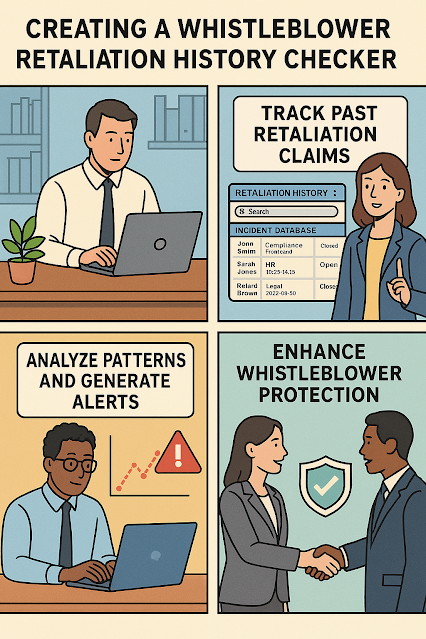How to Create a Whistleblower Retaliation History Checker for Ethics Officers
Whistleblower protections are a crucial part of a company’s ethical backbone, yet retaliation still occurs far too often.
Ethics officers need reliable, real-time tools to detect patterns and evaluate risks related to past retaliation claims.
In this guide, we’ll explore how to build a Whistleblower Retaliation History Checker tailored for ethics officers working within compliance, legal, and HR teams.
📌 Table of Contents
- Why Ethics Officers Need a Retaliation History Checker
- Core Features of a Retaliation History Checker
- Trusted Data Sources and API Integration
- Recommended Tech Stack for Development
- Privacy, Ethics, and Legal Boundaries
- Implementation Guide & Integration
- External Tools & Further Reading
Why Ethics Officers Need a Retaliation History Checker
Many companies have policies to protect whistleblowers, but these policies often fail without strong monitoring mechanisms.
A history checker helps ethics officers:
- Detect repeated offender departments or supervisors
- Track unresolved or hidden retaliation reports
- Generate audit trails and trend analytics
- Protect the organization from legal liability
Core Features of a Retaliation History Checker
To be effective, the checker should offer:
1. Incident Database: A centralized repository of whistleblower complaints and retaliation claims.
2. Searchable Profiles: Employee-level profiles showing history of involvement in whistleblower cases.
3. Pattern Recognition: AI-driven analysis to detect repeated retaliation behaviors.
4. Alerts & Reports: Scheduled reporting or alerts when patterns reoccur.
5. Anonymous Input: Safe channels for employees to report retaliation anonymously.
Trusted Data Sources and API Integration
To ensure credibility, your tool should pull from:
- Internal HR case logs
- Ethics hotline and whistleblower platforms (like NAVEX)
- EEOC retaliation statistics
- Public court records and legal filings
🔗 Learn more about NAVEX whistleblower tools
Visit NAVEX Whistleblower SolutionsRecommended Tech Stack for Development
If you're building this tool internally or as a SaaS, consider the following tech components:
Backend: Node.js or Python (Flask/Django)
Frontend: React or Vue with strong dashboard libraries (like Recharts, D3)
Database: PostgreSQL with audit logging features
AI/ML: TensorFlow or Scikit-learn for pattern detection
Security: Role-based access control (RBAC), end-to-end encryption
Privacy, Ethics, and Legal Boundaries
When working with retaliation data, confidentiality is non-negotiable.
Make sure your solution:
- Complies with GDPR, CCPA, and relevant labor laws
- Offers redaction tools for sensitive data
- Provides access logs and transparency features
- Discloses data use policies to all internal users
Implementation Guide & Integration
Here’s a step-by-step approach to get started:
1. Conduct a needs assessment with compliance teams
2. Draft user stories for ethics officers
3. Build a prototype MVP focusing on high-risk departments
4. Integrate with existing HR systems (SAP, Workday, etc.)
5. Run internal audits and pilot tests before full rollout
External Tools & Further Reading
Several platforms can help you fast-track development or benchmarking:
1. EthicsPoint: Managed hotline service with case management tools
2. EQS Integrity Line: European-based whistleblowing system with GDPR compliance
3. Ethisphere Institute: Industry research and benchmarking standards
🔗 Visit EQS Whistleblower Platform
Explore EQS Integrity Line🔗 Learn from Ethisphere Benchmarking
Visit EthisphereConclusion
Creating a Whistleblower Retaliation History Checker is more than just a technical challenge—it’s a vital step in reinforcing ethical accountability in your organization.
By combining secure infrastructure, intelligent analytics, and compliance-first design, ethics officers can gain an indispensable tool in protecting whistleblowers and building trust across the workforce.
Keywords: whistleblower retaliation, ethics officers, compliance tools, corporate ethics, retaliation checker

